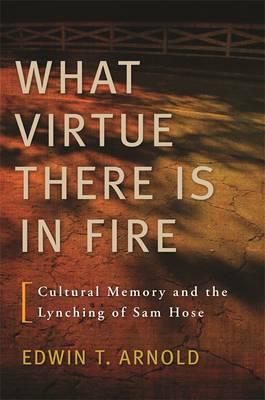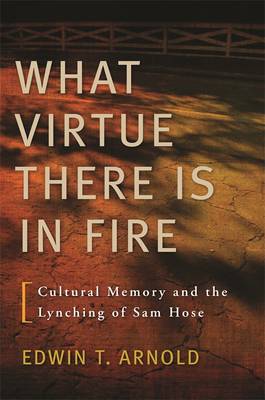
- Retrait gratuit dans votre magasin Club
- 7.000.000 titres dans notre catalogue
- Payer en toute sécurité
- Toujours un magasin près de chez vous
- Retrait gratuit dans votre magasin Club
- 7.000.0000 titres dans notre catalogue
- Payer en toute sécurité
- Toujours un magasin près de chez vous
What Virtue There Is in Fire
Cultural Memory and the Lynching of Sam Hose
Edwin T Arnold
Livre broché | Anglais
56,45 €
+ 112 points
Description
The 1899 lynching of Sam Hose in Newnan, Georgia, was one of the earliest and most gruesome events in a tragic chapter of U.S. history. Hose was a black laborer accused of killing Alfred Cranford, a white farmer, and raping his wife. The national media closely followed the manhunt and Hose's capture. An armed mob intercepted Hose's Atlanta-bound train and took the prisoner back to Newnan. There, in front of a large gathering on a Sunday afternoon, Hose was mutilated and set on fire. His body was dismembered and pieces of it were kept by souvenir hunters.
Born and raised twenty miles from Newnan, Edwin T. Arnold was troubled and fascinated by the fact that this horrific chain of events had been largely shut out of local public memory. In "What Virtue There Is in Fire," Arnold offers the first in-depth examination of the lynching of Sam Hose. Arnold analyzes newspapers, letters, and speeches to understand reactions to this brutal incident, without trying to resolve the still-disputed facts of the crime. Firsthand accounts were often contradictory, and portrayals of Hose differed starkly--from "black beast" to innocent martyr. Arnold traces how different groups interpreted and co-opted the story for their own purposes through the years. Reflecting on recent efforts to remember the lynching of Sam Hose, Arnold offers the portrait of a place still trying to reconcile itself, a century later, to its painful past.Spécifications
Parties prenantes
- Auteur(s) :
- Editeur:
Contenu
- Nombre de pages :
- 264
- Langue:
- Anglais
Caractéristiques
- EAN:
- 9780820340647
- Date de parution :
- 15-01-12
- Format:
- Livre broché
- Format numérique:
- Trade paperback (VS)
- Dimensions :
- 145 mm x 216 mm
- Poids :
- 362 g

Les avis
Nous publions uniquement les avis qui respectent les conditions requises. Consultez nos conditions pour les avis.






